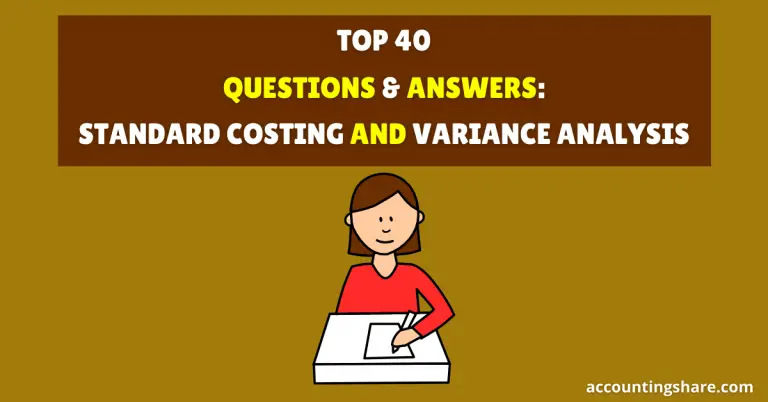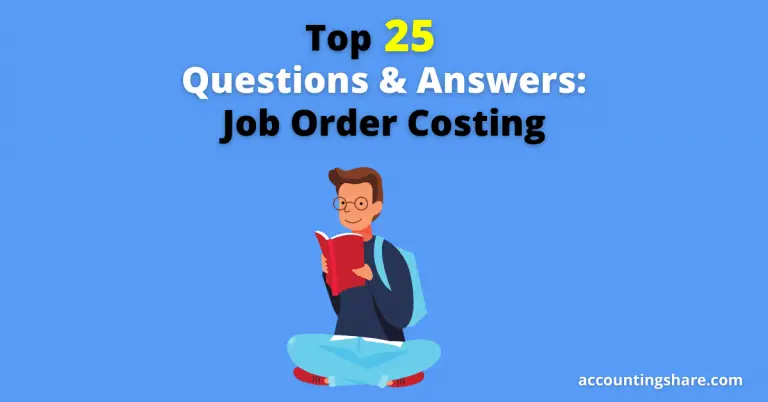Top 20 Questions and Answers- Activity-Based Costing (ABC) [With PDF]
Here, you will learn the top 20 Questions and Answers- Activity-Based Costing (ABC). After reading this article, you will have a basic idea about activity-based costing (ABC).
So let’s get started.
Questions and Answers- Activity-Based Costing (ABC)
Question-01: What is Activity-Based Costing (ABC)?
Answer: Activity-Based Costing (ABC) is the costing that begins with the tracking of activities and then the output of the product. In other words, it is the costing method mechanism that focuses on activities conducted for the manufacture of goods.
Question-02: What is the main purpose of Activity-Based Costing (ABC)?
Answer: The main purpose of the Activity-Based Costing (ABC) is to define as many costs as possible that is subsequently compensated for as direct production costs.
Question-03: What are the different stages in Activity-Based Costing (ABC)?
Answer: There are various stages in the ABC system. Activity-based costing’s important stages are as follows:
- Identify the various activities that take place within the company.
- Measure the overhead costs as a result of the operations.
- Subsequently, support activities are dispersed in the primary activities.
- Identify the cost drivers for each activity.
- Determine the rate of activity cost drivers, or the number of cost drivers used by each product.
Question-04: What is the distinction between Activity-Based Costing and Traditional Costing?
Answer:
- Activity-based costing starts with the identification of activities and then the production of goods, while traditional costing starts with the identification of costs and then the production of goods.
- Activity Based Costing focuses primarily on activities carried out for the manufacture of products, whereas Traditional Costing focuses primarily on cost determination after they have been incurred.
Question-05: What are the Advantages of Activity-Based Costing?
Answer: The ABC system is an extremely valuable control tool. It provides a number of management benefits and the main advantages are the following:
- In determining the cost of the products, it provides accuracy and reliability of cost data.
- It facilitates the relationship of cause and effect to exercise effective control of costs.
- It provides the management with the necessary cost information to make decisions on any business-related matter.
- It is very useful to set the cost and the selling price of a product.
- It facilitates the allocation of overhead costs directly to a specific product.
Question-06: What are the limitations or disadvantages of ABC?
Answer: The limitations or disadvantages of ABC are as follows:
- ABC is very expensive to use.
- Some arbitrary allocations continue.
Question-07: What are the essentials factors of a good Activity-Based Costing system?
Answer: The success of the Activity-Based Costing system depends on the following factors:
- Costing system objectives and level of competition.
- Number of fabricated products.
- Business and product diversity
- Adaptation of measures, standardization and technical aspects of cost management.
- Degree of sophistication and business suitability.
Question-08: What are the costs drivers?
Answer: Cost Drivers are known as the factors that influence the cost of a specific activity.
Question-09: What are the examples of cost drivers?
Answer: The examples of cost drivers are as follows:
- Number of receiving the order
- Number of deliveries
- Number of Purchase orders
- Kilometres travelled per delivery
- Number of customers’ visits
- Number placing orders for purchase
Question-10: What is the Importance of Cost Drivers?
Answer: the Importance of Cost Drivers is as follows:
- Cost drivers describe what causes a cost to be incurred in order to regulate it.
- Cost drivers should decide at what point a cost arises.
Question-11: What is the example of activities?
Answer: The example of activities are as follows:
- Ordering
- Delivery
- Order Taking
- Deliveries
- Customer Visit
- Placing Orders
Question-12: What is the classification of activities?
Answer: Activities are classified into:
- Unit Level Activities
- Batch Level Activities
- Product Level Activities
- Facility Level Activities
Question-13: What are the unit-level activities?
Answer: Unit Level Activities are those activities carried out whenever a single product or unit is manufactured. Such activities are repetitive in nature. For example, direct labour hours, machine hours, power, etc.
Question-14: What is the Batch Level Activity?
Answer: These activities are carried out whenever a batch of products or a group of identical products is manufactured. In nature and in size, all the units of a specific batch are uniform. Examples of batch-level activities that are related to batches are machine setups, inspections, production scheduling, materials handling.
Question-15: What are the product-level activities?
Answer: These activities are carried out to support the manufacturing of each type of product. A few examples of product-level activities are maintenance of equipment, engineering fees, testing routines, maintaining material bills, etc.
Question-16: What are the Facility Level Activities?
Answer: Facility Level Activities are those that are needed to sustain the general production process of a factory. These activities are prevalent in a variety of products and are most difficult to link to specific activities of the product. A few examples of facility-level activities include factory management, maintenance, security, plant depreciation, etc.
Question-17: How to calculate activity-based overhead rate?
Answer:
Activity-based overhead rate = Estimated Overhead per Activity/Expected Cost Drivers per Activity
Question-18: What is the costs hierarchy?
Answer: A cost hierarchy classifies costs into different cost pools based on the different types of bases for cost allocation or different degrees of difficulty in determining relationships between benefits received.
Question-19: What is an activity center?
Answer: An activity center is any part of the phase of manufacturing or service for which management requires a separate cost reporting.
Question-20: How do managers use ABC systems to price goods or services?
Answer: Activity costs are used in ABC to allocate costs to other cost items, such as goods or services, depending on the activities consumed by the products or services.
You can also read:
Top Questions and Answers:







